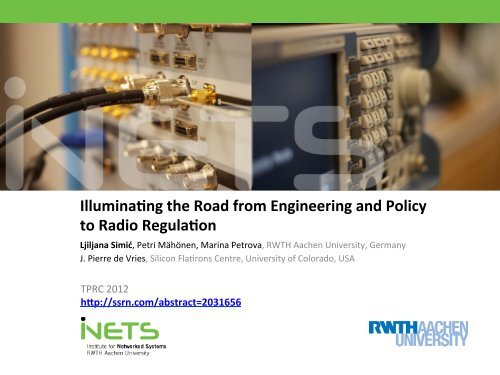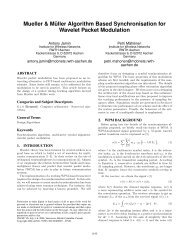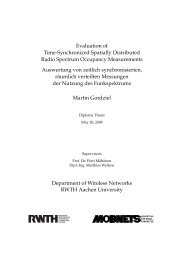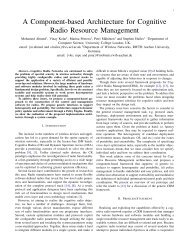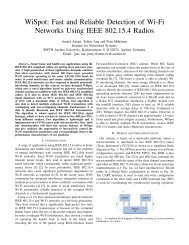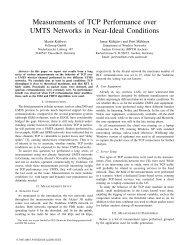slides - iNETS - RWTH Aachen University
slides - iNETS - RWTH Aachen University
slides - iNETS - RWTH Aachen University
You also want an ePaper? Increase the reach of your titles
YUMPU automatically turns print PDFs into web optimized ePapers that Google loves.
Illumina(ng the Road from Engineering and Policy <br />
to Radio Regula(on <br />
Ljiljana Simić, Petri Mähönen, Marina Petrova, <strong>RWTH</strong> <strong>Aachen</strong> <strong>University</strong>, Germany <br />
J. Pierre de Vries, Silicon FlaBrons Centre, <strong>University</strong> of Colorado, USA <br />
TPRC 2012 <br />
h;p://ssrn.com/abstract=2031656
ObjecBve of our work <br />
• To understand the interplay between engineering, <br />
policies, and radio regulaBon <br />
• Our focus is mainly on radio spectrum allocaBon and use <br />
• More specifically: <br />
• There is a tussle, paraphrasing David D. Clark <br />
• However, the tussle in radio communicaBons is markedly <br />
different both historically and today when compared to <br />
Internet development <br />
• The underlying quesBon is how to efficiently allocate <br />
scarce radio spectrum, and how sensible decisions can <br />
be made by a regulator
Simplified (engineering) view of the problem <br />
• Policies are developed by policy makers with <br />
a reasonable understanding of technology <br />
• Engineers develop efficient systems based on <br />
policy constraints <br />
• Stakeholders will tussle with the regulators & <br />
market place to acquire spectrum licenses <br />
• Market forces and ‘adversary’ compeBBon will <br />
ensure (nearly) efficient allocaBon
QuesBons <br />
• So if the previous is true: <br />
• Why are there failures in the market place? <br />
• Why are the efficiency claims between stakeholders <br />
so widely different? <br />
• Why do different processes end up at widely different <br />
outcomes? <br />
• GSM (success) <br />
• Wi-‐Fi (success) <br />
• HiperLAN, WiMAX, … <br />
• Is it hit & miss with unpredictable markets, or could the <br />
engineering community help to streamline the process?
þ It’s Complicated <br />
Gedng away from Cargo Cult Engineering <br />
and Oversimplified Success Stories
RecommendaBons in 20 seconds <br />
• Transparency <br />
• Embrace N-‐dimensionality <br />
• Disclosure of interests <br />
• Systems perspec(ve <br />
• Technology Circle <br />
• Fail-‐Safe designed into regulaBon
From 1-‐dimensional design space… <br />
• The complexity of wireless systems has not been usually <br />
considered transparently and explicitly <br />
• There is a natural tendency in wireless community to try to <br />
characterize efficiency using a single or very few quanBtaBve <br />
numbers (and markeBng departments do not help us): <br />
• Spectral efficiency: bps/Hz <br />
• Maximum aggregate throughput: bps <br />
• Power consumpBon: bps/W
…to N-‐dimensional design space <br />
• Reality tends to bite! <br />
• “Everything should be as simple as possible, <br />
but not simpler”, A. Einstein <br />
• Wireless systems are complex: <br />
• IniBal assumpBons & policy constraints <br />
will affect strongly the performance metrics <br />
• Single metric is usually nearly useless, e.g. <br />
throughput (“bandwidth”) can be highly different if you ask <br />
average, cell-‐edge, or maximum theoreBcal value: <br />
Antenna <br />
config. <br />
Average <br />
spectrum <br />
efficiency <br />
(bps/Hz/cell) <br />
Cell edge spectrum <br />
efficiency <br />
(bps/Hz/cell/user) <br />
Average spectrum efficiency <br />
(bps/Hz/cell) by a vendor es(mate <br />
UPLINK <br />
1x2 <br />
2x4 <br />
1.2 <br />
2.0 <br />
0.04 <br />
0.07 <br />
1.39 <br />
2.25 <br />
DOWNLI<br />
NK <br />
2x2 <br />
4x4 <br />
2.4 <br />
3.7 <br />
0.07 <br />
0.12 <br />
2.26 <br />
3.46
TVWS Wi-‐Fi as an example <br />
• TVWS someBmes sold as “super Wi-‐Fi” <br />
or “Wi-‐Fi on steroids” <br />
• Certainly true from a certain perspecBve … <br />
• … but different perspecBve can also be provided <br />
• Note: the different conclusions can be reached from <br />
the engineering perspec(ve without excessively using policy <br />
or commercial arguments <br />
L. Simić, M. Petrova, P. Mähönen, "Wi-‐Fi, but not on Steroids: Performance Analysis of a Wi-‐Fi like Network <br />
Opera?ng in TVWS under Realis?c Condi?ons,” in Proc. IEEE ICC, Otawa, 2012.
TVWS Wi-‐Fi as an example <br />
Maximum coverage range [m]<br />
350<br />
300<br />
250<br />
200<br />
150<br />
100<br />
50<br />
TVWS (630 MHz)<br />
2.4 GHz ISM band<br />
5 GHz unlicensed band<br />
Wi-Fi<br />
but not<br />
on steroids!<br />
Average AP downlink rate [Mbps]<br />
30<br />
25<br />
20<br />
15<br />
10<br />
5<br />
0<br />
0 5 10 15 20 25 30<br />
Transmission power [dBm]<br />
TVWS (630 MHz)<br />
2.4 GHz ISM band<br />
5 GHz unlicensed band<br />
0<br />
0 5 10 15 20 25 30<br />
Transmission power [dBm]<br />
Average spectral efficiency [bit/s/Hz]<br />
1<br />
0.9<br />
0.8<br />
0.7<br />
0.6<br />
0.5<br />
0.4<br />
0.3<br />
0.2<br />
0.1<br />
TVWS (630 MHz)<br />
2.4 GHz ISM band<br />
5 GHz unlicensed band<br />
0<br />
0 5 10 15 20 25 30<br />
Transmission power [dBm]
Average AP downlink rate [Mbps]<br />
30<br />
25<br />
20<br />
15<br />
10<br />
5<br />
So which frequency is king? <br />
outdoor urban, P tx<br />
= 20 dBm<br />
indoor urban, P tx<br />
= 20 dBm<br />
Average spectral efficiency [bit/s/Hz]<br />
1.5<br />
1<br />
0.5<br />
indoor urban, P tx<br />
= 20 dBm<br />
outdoor urban, P tx<br />
= 20 dBm<br />
0<br />
0 0.63 2.4 5<br />
Frequency [GHz]<br />
0<br />
0 0.63 2.4 5<br />
Frequency [GHz]<br />
Average band spectral efficiency [bits/s/Hz]<br />
1.5<br />
1<br />
0.5<br />
indoor urban, P tx<br />
= 20 dBm<br />
outdoor urban, P tx<br />
= 20 dBm<br />
…all of them! <br />
0<br />
0 0.63 2.4 5<br />
Frequency [GHz]
Embracing N-‐dimensionality <br />
• Instead of hiding the complex N-‐dimensionality <br />
of systems, we should transparently describe it <br />
• State clearly assump(ons <br />
• Provide many plots and even visualizaBon tools to show issues <br />
• Any single 2-‐D slice out of full N-‐dimensional space can be misleading <br />
Cell size (m)<br />
Spectral efficiency (bits/s/Hz)<br />
Spectral efficiency (bits/s/Hz/m 2 )<br />
Frequency (Hz)<br />
Frequency (Hz)<br />
Frequency (Hz)
Disclosure of interests <br />
• Regulators need to judge the credibility <br />
of technical evidence supplied by stakeholders: <br />
• Complexity of design space forces the regulator <br />
to assign relaBve importance and correctness of <br />
technical arguments for compeBng soluBons <br />
• Current regulatory process aims at this, but is it efficient enough? <br />
• Very litle independent amica curae help available <br />
• Adversaries are mostly blocks (in technical sense): Open vs. Cellular etc. <br />
• We can learn from different regulatory approaches, e.g. FDA: <br />
• FDA has insBtuted a process requiring disclosure <br />
of financial interests in order to alert its staff to potenBal <br />
bias in submited evidence and reliability of clinical data
Enforcing a systems view <br />
• Both quanBtaBve and qualitaBve consideraBons exists <br />
• …and should be a part of the decision making process <br />
• neither is superior & should not try to quanBfy qualitaBve arguments <br />
• Engineering community is not parBcularly good with qualitaBve <br />
arguments, nor at combining qualitaBve & quanBtaBve analysis <br />
into a single coherent systems view <br />
• Need to have framework to support and enforce systems view
Technology Circle <br />
• Moving from OSI network layer stack to Technology Circle <br />
• TC Bes in engineering, regulaBon, and business models <br />
network stack <br />
(OSI layers 1-‐7) <br />
2<br />
3<br />
5<br />
4 6<br />
7<br />
1<br />
0<br />
8<br />
‟Layer Eight” <br />
business models <br />
& social prac
Fail-‐safe engineering & regulaBon <br />
• Any complex system is beyond exact predicBons <br />
• SensiBvity to iniBal values and assumpBons <br />
• Difficult to know all the dynamics <br />
• Markets and technology evolve over the Bme <br />
• Do not try to make it perfect, instead incorporate <br />
fail-‐safe mechanisms into regulaBon and systems engineering <br />
• Resilience of decisions: revisited & corrected as necessary <br />
• Alloca
Conclusions <br />
• Do not hide complexity, embrace it openly <br />
• Require N-‐dimensional analysis & <br />
full disclosure of assumpBons <br />
• Engage engineers in the process <br />
• Require transparency in analysis, but also in conflicts of interest <br />
• DeclaraBon of interests required or incenBvized <br />
• Support and require systems view in processes and analysis <br />
• Educate future engineers on policy & regulatory issues <br />
• Educate & provide support for policy makers on engineering & regulaBon <br />
• Support regulators with engineering analysis & explicit policy frameworks <br />
• RegulaBon and policies themselves may need to also consider <br />
how to build-‐in fail-‐safe procedures


